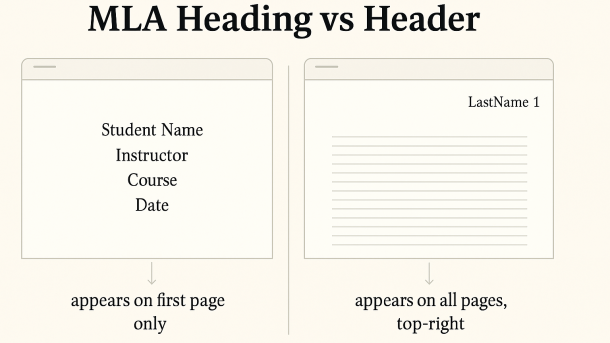The MLA heading is a four-line block on the first page only (student name, instructor, course, date), aligned left above the title. The MLA header is the repeating last-name–page-number label in the page’s top-right corner on every page. Format both with one-inch margins and double spacing.
What Is the MLA Heading?
In MLA style, the heading is the identity block that appears once on page 1—above the paper’s title and the first paragraph. Its job is simple: tell the reader who wrote the paper, for whom, for which course, and when. Unlike a cover page, this heading replaces the need for a separate title page in most classes.
Essential rules you can trust:
-
Placement & alignment: top of the first page, flush left.
-
Spacing: the heading lines are double-spaced (no extra blank lines).
-
Order of lines: Student Name, Instructor’s Name, Course (or course code), Date.
-
Date style: day month year without commas (e.g., 12 October 2025).
-
Title: after the heading, add one double-spaced blank line, then center the paper’s title (standard capitalization, no bold, no italics, no underline, unless your title includes a work’s title).
Here’s how a correctly formatted first page might look (monospaced for clarity):
Key takeaway: The heading is unique to page 1 and never repeats. It sits in the page body, not in the document’s header area.
Fine-tuning the heading for readability
While MLA does not mandate a single “brand” font, it expects a legible, widely used typeface (e.g., 12-pt Times New Roman). Maintain one-inch margins on all sides and 0.5-inch first-line indents for body paragraphs. Avoid extra spacing before/after paragraphs; the entire document remains double-spaced throughout.
What Is the MLA Header?
By contrast, the header in MLA is the running identifier that appears on every page, including the first page, in the top-right corner. It contains your last name and the page number separated by a single space (e.g., Doe 1, Doe 2, Doe 3 …).
Why it matters: The header helps instructors keep pages in order and identify your work if pages are separated. It belongs to the document’s header section (the margin band at the top), not to the page’s body text.
Formatting at a glance:
-
Content: Last name + space + automatic page number.
-
Position: Top-right, 0.5 inch from the top edge, aligned right.
-
Scope: All pages, including page 1.
-
Spacing: Same font and size as the body; no bold or italics.
How to set the header in Microsoft Word (Windows or Mac):
-
Insert cursor anywhere on page 1 → Insert → Header (or double-click the top margin area).
-
Choose a blank header; press Tab until the cursor is flush right. Type your last name and add a space.
-
Go to Insert → Page Number → Current Position → Plain Number.
-
Ensure font and size match your body text; set header spacing to 0.5″ from top if needed. Close Header & Footer.
(For Google Docs: open Insert → Page numbers → Top-right, then type your last name before the number with a space; confirm right alignment and 0.5″ top margin for the header area.)
Key takeaway: The header repeats automatically on every page and lives in the margin’s header section, not in the document body.
MLA Heading vs Header — The Differences That Matter
To eliminate confusion, use this concise comparison. The heading and header serve different purposes, live in different parts of the page, and follow different repetition rules.
| Element | Purpose | Where it lives | Appears on | What it contains | Alignment & spacing |
|---|---|---|---|---|---|
| Heading | Identifies the paper and course context | Page body, top of page 1 | First page only | Student Name; Instructor; Course; Date | Flush left; double-spaced lines |
| Header | Tracks author & sequence across pages | Header region (margin band) | Every page, including page 1 | Last name + page number | Top-right; 0.5″ from top; same font/size as body |
Simple rule of thumb: Heading = four lines in the body on the first page. Header = last-name page number in the top-right corner on every page.
Why mix-ups happen (and how to avoid them)
Students often type the last name and page number into the body text on page 1, or they repeat the four-line heading on page 2. Both are incorrect because the header must live in the header band (so page numbers update automatically), and the heading never repeats.
How to Format Both Consistently (Margins, Fonts, Spacing, Titles)
Consistency sells your credibility. Apply these cross-document settings before you even start writing:
Margins & indents. Set 1-inch margins on all sides in your word processor. Set First-line indent to 0.5″ for normal paragraphs (Home → Paragraph → Special: First line = 0.5″). The title line itself is not indented; paragraphs below the title are.
Font & size. Choose a highly readable serif or sans-serif font used in academic contexts (12-pt Times New Roman remains a common default). Keep the same font in the heading, header, and body.
Line spacing. Use double spacing everywhere: heading, title, paragraphs, block quotations, and Works Cited entries. Remove any “extra space after paragraph” settings that some templates add.
Title handling. After the heading on page 1, insert one double-spaced blank line, then center your title in Title Case. Do not bold or underline it (unless your title includes the title of a work, which may require italics or quotation marks per MLA’s normal rules).
No title page by default. MLA generally doesn’t require a separate title page. If your instructor requires one, follow their instructions; otherwise, the heading + centered title approach on page 1 is standard.
Headers on every page. Once you set the header correctly, check page 1, page 2, and the last page to confirm it updates automatically and stays in the top-right margin.
Works Cited page. When you later add a Works Cited page, it remains part of the same document, so the header continues (e.g., Doe 6). Keep the same margins, font, and spacing rules.
Common Mistakes and Quick Fixes
-
Putting the last name + page number in the body, not the header. Fix by moving it into the header section so numbering is automatic.
-
Repeating the four-line heading on page 2 or beyond. It belongs on page 1 only.
-
Using commas in the date (e.g., “October 12, 2025”). MLA uses day month year: 12 October 2025.
-
Forgetting to center the title or styling it (bold/underline). Keep the title centered and plain.
-
Inconsistent fonts/sizes between body, heading, and header. Standardize to one font and size across the document.
-
Extra blank lines before/after paragraphs. Ensure double spacing only, no additional spacing.
-
Missing first-line indents for paragraphs under the title. Set 0.5″ first-line indents globally.
Example of a Fully Correct First Page
If you remember nothing else: heading = one-time identity block on page 1; header = repeating last-name–page-number on every page. Set both correctly once, and they’ll keep your paper clean, credible, and MLA-compliant.




